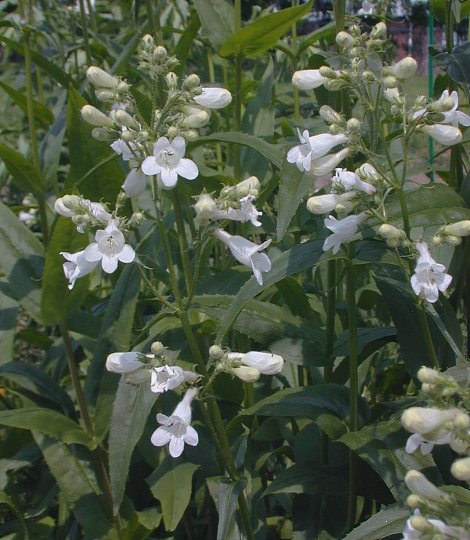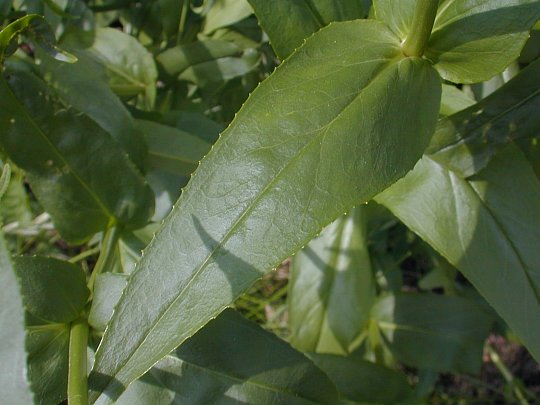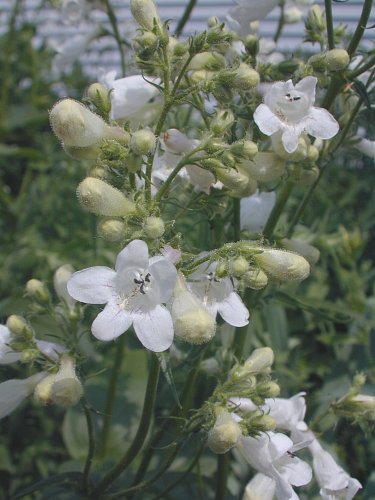Description: Prior to developing an inflorescence, this perennial plant consists of one or more rosettes of basal leaves that are clustered together. They are medium green, sometimes with reddish tints. They are variable in shape, but tend to be ovate, obovate, or broadly lanceolate, and are up to 6" long and 2½" wide. Their margins are usually smooth. One or more flowering stalks emerge from the clustered rosettes during the spring, which are about 3' tall. They are hairless and light green, while the opposite leaves on these stalks are more lanceolate in shape than the basal leaves. Their edges often have tiny teeth, and the leaf surface is often shiny.

The white flowers
occur in a panicle at the top of each flowering stem, and bloom during
late spring or early summer for about a month. They are tubular in
shape and about 1" long, with the corolla divided into a lower lip with
3 lobes and and an upper lip with 2 lobes. Somtimes there are fine
lines of violet within the corolla, which function as nectar guides to
visiting insects. There is no floral scent. The entire plant is
hairless, except on the outer surface of the flowers. The flowering
stalk eventually turns dark brown, developing numerous oval seed
capsules, each containing numerous seeds. These seeds are gray, finely
pitted, and irregularly angled. This inflorescence eventually falls
over are the seeds have formed, helping to distribute them, but the
basal leaves remain. The small seeds can also be carried aloft by the
wind for short distances. The root system has short rhizomes, which
often produce new plantlets around the base.
Cultivation:
The preference is full or partial sun, average levels of moisture, and
loamy soil. This plant matures quickly during the spring, and the
flowering stalks often ascend above neighboring plants. It adapts well
to cultivation, is not bothered by disease, and is easy to grow. Under
severe drought conditions, however, the leaves may turn yellow and the
plant will wilt.

Range &
Habitat:
The native Foxglove Penstemon occurs occasionally, except in some
counties of
central and NW Illinois, where it is uncommon or absent (see Distribution
Map). However, in other areas, it may be locally common.
Habitats include mesic black soil prairies, openings in upland and
floodplain forests, woodland borders, thickets, savannas, acid gravel
seeps, pastures, and abandoned fields.
Faunal Associations:
The tubular flowers of this plant attract long-tongued bees, including
honeybees, bumblebees, Anthophorine bees, Miner bees, Mason bees, and
large Leaf-Cutting bees. To a lesser extent, Halictid bees,
butterflies, Sphinx moths, and hummingbirds may visit the flowers, but
they are not effective pollinators. The caterpillars of the moth Elaphria
chalcedonia (Chalcedony Midget) feed on the foliage of this
and other beardtongues. There have been reports that the caterpillars
of the butterfly Euphydryes phaeton (Baltimore)
feed on the foliage of various beardtongues, but this does not appear
to be the case in Illinois. The seeds are not often eaten by birds, nor
is the foliage an attractive source of food to mammalian herbivores,
although they may browse on it when little else is available.

Photographic
Location:
The photographs were taken at the webmaster's wildflower garden in
Urbana, Illinois.
Comments:
This is probably the easiest Penstemon sp. to grow
in areas that lie east of the Mississippi river. The flowers are quite
showy, and the plant is large enough to compete against many kinds of
weeds. Another desirable feature is that the blooming period is rather
long for an early season plant. Foxglove Penstemon can be distinguished
from other members of the genus by the absence of hairs on the leaves
and stems, a corolla that is primarily white on the outer surface (but
sometimes with violet tints), the presence of tiny white hairs on the
anthers (resembling small combs), and an absence of ridges on the lower
inner surface of the corolla. The small hairs on the anthers can lodge
against the hairs of a visiting bee, causing the stamens to bend
downward to deposit pollen on the back of the insect, if it is
sufficiently large in size.